Performance of a Propeller Coated with Hydrophobic Material
Abstract
:1. Introduction
2. Numerical Simulation
2.1. The Propeller
2.2. Meshing and Boundary Conditions
3. Numerical Calculation Results and Analysis
3.1. Hydrodynamic Performance of the Propeller
3.2. Analysis of the Results of Propeller Blade Pressure
3.3. Analysis of Propeller Wake and Vortex
4. Experimental Study
4.1. Test Propellers
4.2. Experimental Platform and Experimental Method
4.3. Experimental Results and Analysis
5. Conclusions
- (1)
- Comparing the CFD results of the conventional propeller and the propellers coated with the hydrophobic material assuming different surface slip rates, it can be concluded that the propellers coated with the hydrophobic material were more efficient. The increased efficiency of the propellers coated with the hydrophobic material was dependent on the surface slip rate, advance coefficient, and rotational speed. For most of the situations, efficiency improvement increased as the surface slip rate, advance coefficient, and rotational speed increased.
- (2)
- The comparisons of the PIV experiment results and CFD numerical simulation results showed that the calculated flow field of the propeller with a surface slip rate of 75% was closer to the test results of the propeller coated with the PVDF dimethylformamide solvent. The results showed that the propeller coated with the hydrophobic material reduced the size of the low-speed wake zone behind the hub.
- (3)
- Blade surface pressure distributions showed that the pressure difference between the pressure surface and suction surface of the propellers coated with the hydrophobic material was larger than that of the conventional propeller, helping to increase the thrust of the propeller.
- (4)
- Compared with the conventional propellers, the strength of the tip vortex and the hub vortex of the propellers coated with the hydrophobic material were significantly reduced.
- (5)
- The CFD results showed that the propeller coated with hydrophobic propeller increased its thrust and efficiency. This finding was not reported within our literature search. Using the surface boundary condition of non-slip and free slip boundary conditions at different parts of the surface area with different area proportions defined as different surface slip rates is a novel method to use CFD software to study flow with hydrophobic walls.
- (6)
- New wall models could be developed for wall boundary conditions suited for walls coated with hydrophobic materials. Since there exist many types of hydrophobic materials, the future development in this topic is quite open. Another obvious future task is to produce a large propeller coated with hydrophobic materials to measure its hydrodynamic performance.
Author Contributions
Funding
Institutional Review Board Statement
Informed Consent Statement
Data Availability Statement
Conflicts of Interest
References
- Knight, B.G.; Maki, K.J. A semi-empirical multi-degree of freedom body force propeller model. Ocean. Eng. 2019, 178, 270–282. [Google Scholar] [CrossRef]
- Wang, L.; Martin, J.E.; Felli, M.; Carrica, P.M. Experiments and CFD for the propeller wake of a generic submarine operating near the surface. Ocean. Eng. 2020, 206, 107304. [Google Scholar] [CrossRef]
- Ebrahimi, A.; Razaghian, A.H.; Seif, M.S.; Zahedi, F.; Nouri-Borujerdi, A. A comprehensive study on noise reduction methods of marine propellers and design procedures. Appl. Acoust. 2019, 150, 55–69. [Google Scholar] [CrossRef]
- Kim, H.; Leong, Z.Q. Numerical testing and verification of a marine propeller operating in a uniform flow field. Ships Offshore Struct. 2021, 162, 120–126. [Google Scholar] [CrossRef]
- Kapuria, S.; Das, H.N. Improving hydrodynamic efficiency of composite marine propellers in off-design conditions using shape memory alloy composite actuators. Ocean. Eng. 2018, 168, 185–203. [Google Scholar] [CrossRef]
- Liu, B.; Vanierschot, M. Numerical study of the hydrodynamic characteristics comparison between a ducted propeller and a rim-driven thruster. Appl. Sci. 2021, 11, 4919. [Google Scholar] [CrossRef]
- Cui, Y.; Lam, W.H.; Puay, H.T.; Ibrahim, M.S.; Robinson, D.; Hamill, G. Component velocities and turbulence intensities within ship twin-propeller jet using CFD and ADV. J. Mar. Sci. Eng. 2020, 8, 1025. [Google Scholar] [CrossRef]
- Lungu, A. Hydrodynamic loads and wake dynamics of a propeller working in oblique flow. In Proceedings of the ModTech International Conference-Modern Technologies in Industrial Engineering VIII, Iasi, Romania, 23–27 June 2020. [Google Scholar]
- Lee, I.; Park, S.; Seok, W.; Rhee, S.H. A study on the cavitation model for the cavitating flow analysis around the marine propeller. Math. Probl. Eng. 2021, 2021. [Google Scholar] [CrossRef]
- Wei, Y.; Wang, Y.; Ding, K.; Fu, J. Submarine underwater structure-borne noise and flow noise due to propeller exitation. Acoust. Aust. 2012, 402, 122–127. [Google Scholar]
- Helal, M.M.; Ahmed, T.M.; Banawan, A.A.; Kotb, M.A. Numerical prediction of the performance of marine propellers using computational fluid dynamics simulation with transition-sensitive turbulence model. Proc. Inst. Mech. Eng. Part M J. Eng. Marit. Environ. 2019, 2332, 515–527. [Google Scholar] [CrossRef]
- Li, J.; Wei, Y.; Huang, Z.; Wang, F.; Yan, X.; Wu, Z. Electrohydrodynamic behavior of water droplets on a horizontal super hydrophobic surface and its self-cleaning application. Appl. Surf. Sci. 2017, 403, 133–140. [Google Scholar] [CrossRef] [Green Version]
- Taghvaei, E.; Moosavi, A.; Nouri-Borujerdi, A.; Daeian, M.; Vafaeinejad, S. Superhydrophobic surfaces with a dual-layer micro-and nanoparticle coating for drag reduction. Energy 2017, 125, 1–10. [Google Scholar] [CrossRef]
- Bullee, P.A.; Verschoof, R.A.; Bakhuis, D.; Huisman, S.G.; Sun, C.; Lammertink, R.G.; Lohse, D. Bubbly drag reduction using a hydrophobic inner cylinder in Taylor–Couette turbulence. J. Fluid Mech. 2020, 883. [Google Scholar] [CrossRef] [Green Version]
- Lyu, S.; Nguyen, D.C.; Kim, D.; Hwang, W.; Yoon, B. Experimental drag reduction study of super-hydrophobic surface with dual-scale structures. Appl. Surf. Sci. 2013, 286, 206–211. [Google Scholar] [CrossRef]
- Nouri, N.M.; Sekhavat, S.; Mofidi, A. Drag reduction in a turbulent channel flow with hydrophobic wall. J. Hydrodyn. Ser. B 2012, 243, 458–466. [Google Scholar] [CrossRef]
- Wang, J.; Wang, B.; Chen, D. Underwater drag reduction by gas. Friction 2014, 24, 295–309. [Google Scholar] [CrossRef] [Green Version]
- Choi, H.; Lee, J.; Park, H. Wake structures behind a rotor with superhydrophobic-coated blades at low Reynolds number. Phys. Fluids 2019, 311, 015102. [Google Scholar] [CrossRef]
- Katsuno, E.T.; Dozzi Dantas, J.L.; Nelli Silva, E.C. Analysis of hydrophobic painting in model-scale marine propeller. In Proceedings of the Offshore Mechanics and Arctic Engineering, Madrid, Spain, 17–22 June 2018. [Google Scholar]
- Farkas, A.; Degiuli, N.; Martić, I.; Vujanović, M. Greenhouse gas emissions reduction potential by using antifouling coatings in a maritime transport industry. J. Clean. Prod. 2021, 295, 126428. [Google Scholar] [CrossRef]
- Farkas, A.; Degiuli, N.; Martić, I. The impact of biofouling on the propeller performance. Ocean. Eng. 2021, 219, 108376. [Google Scholar] [CrossRef]
- Sung, H.-G.; Jeong, K.; Heo, J. Performance characteristics of a pintle nozzle using the conformal sliding mesh technique. Aerosp. Sci. Technol. 2017, 61, 85–94. [Google Scholar] [CrossRef]
- Cai, R.-Q.; Chen, F.-M.; Feng, X.-M. Calculation and analysis of the open water performance of propeller by CFD software Fluent. Chuanbo Lixue (J. Ship Mech.) 2006, 105, 41–48. [Google Scholar]
- Yeo, K.B.; Choong, W.H.; Hau, W.Y. Prediction of propeller blade stress distribution through FEA. Appl. Sci 2014, 14, 3054. [Google Scholar]
- Liu, C.; Gao, Y.-S.; Dong, X.-R.; Wang, Y.-Q.; Liu, J.-M.; Zhang, Y.-N.; Cai, X.-S.; Gui, N. Third generation of vortex identification methods: Omega and Liutex/Rortex based systems. J. Hydrodyn. 2019, 312, 205–223. [Google Scholar] [CrossRef]
- Hu, J.; Wang, Y.; Zhang, W.; Chang, X.; Zhao, W. Tip vortex prediction for contra-rotating propeller using large eddy simulation. Ocean. Eng. 2019, 194, 106410. [Google Scholar] [CrossRef]
- Ragni, D.; Van Oudheusden, B.; Scarano, F. 3D pressure imaging of an aircraft propeller blade-tip flow by phase-locked stereoscopic PIV. Exp. Fluids 2012, 522, 463–477. [Google Scholar] [CrossRef] [Green Version]
- Li, G.; Chen, Q.; Liu, Y. Experimental study on dynamic structure of propeller tip vortex. Pol. Marit. Res. 2020, 27, 11–18. [Google Scholar] [CrossRef]
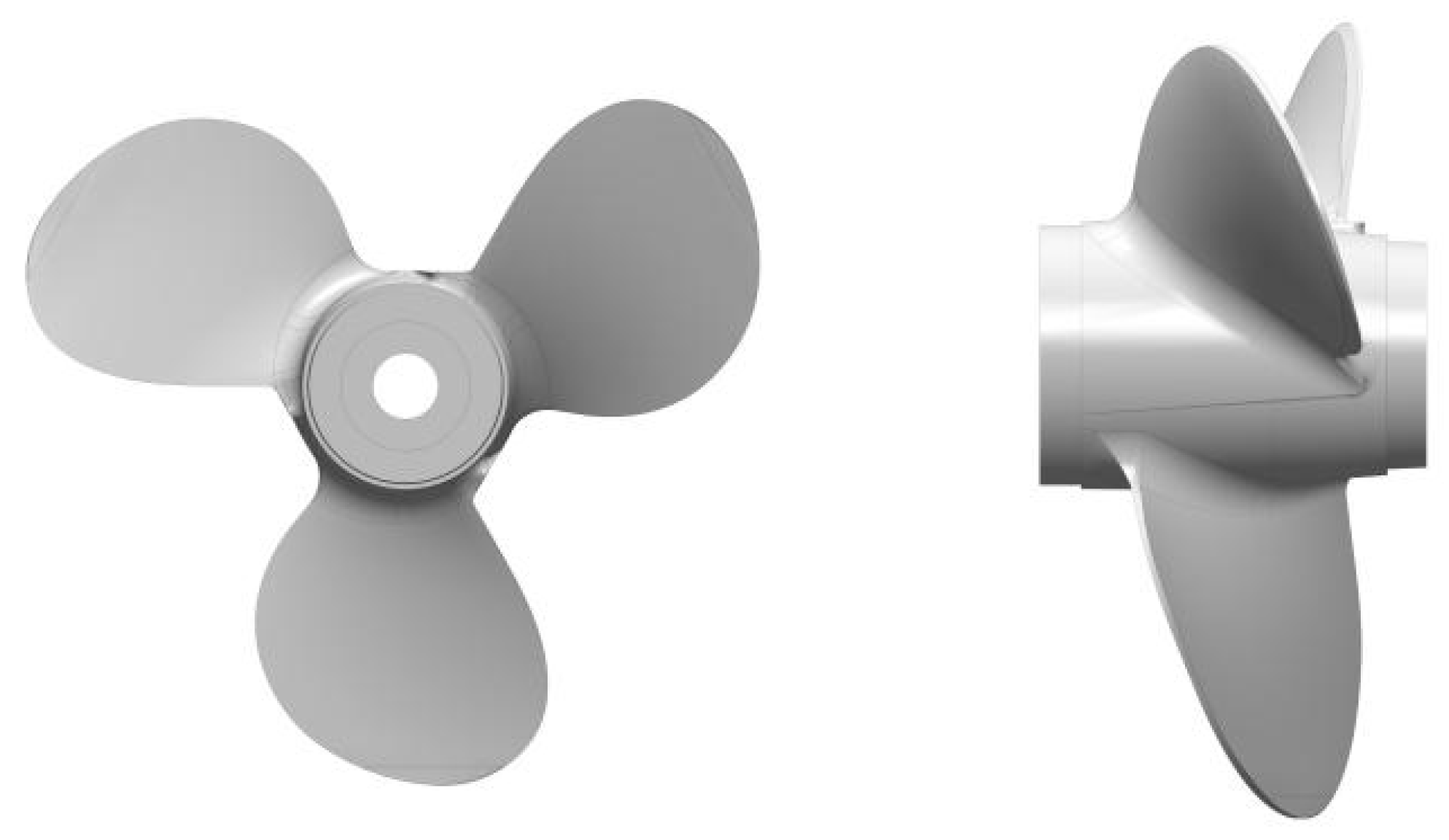

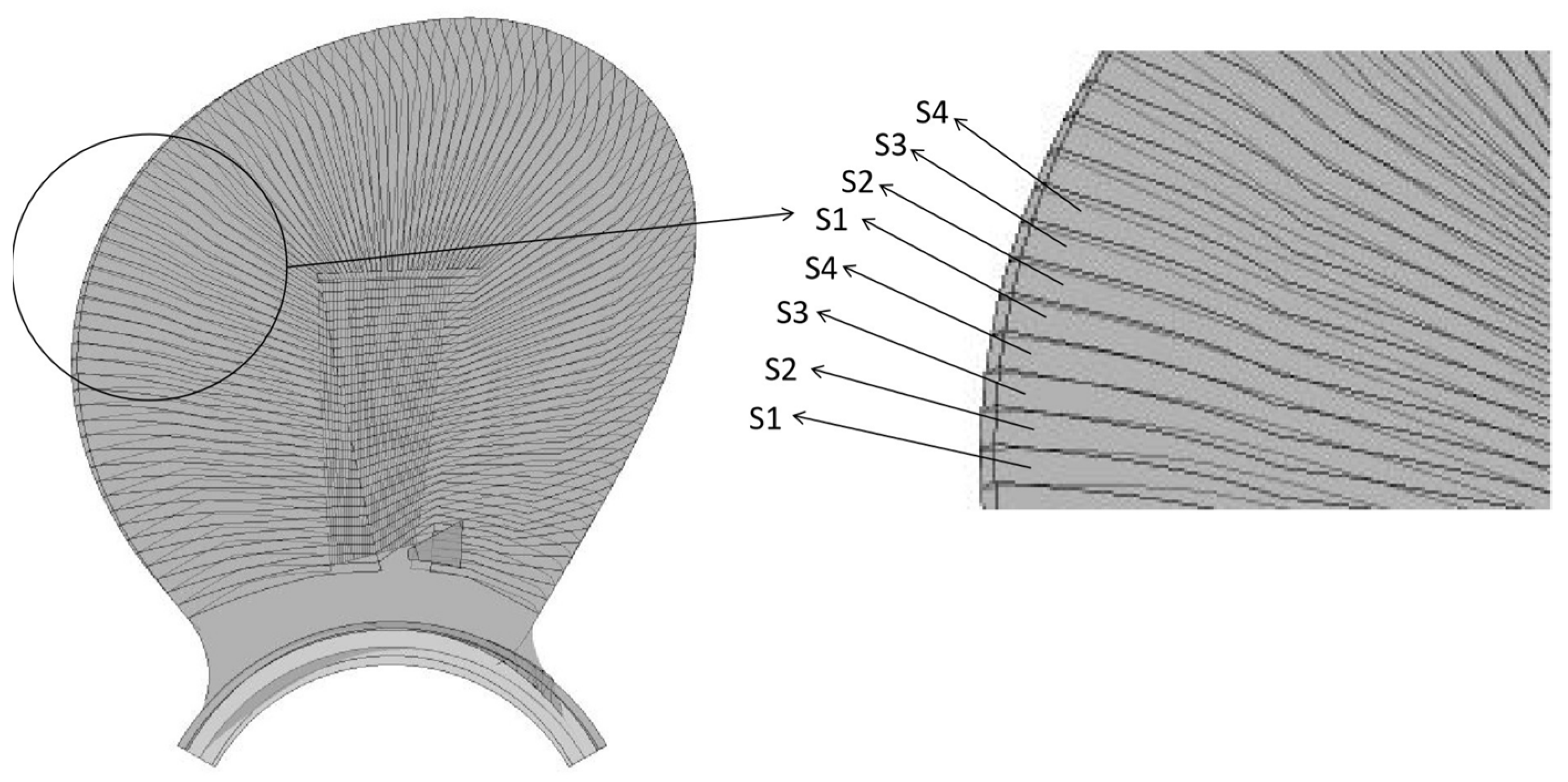
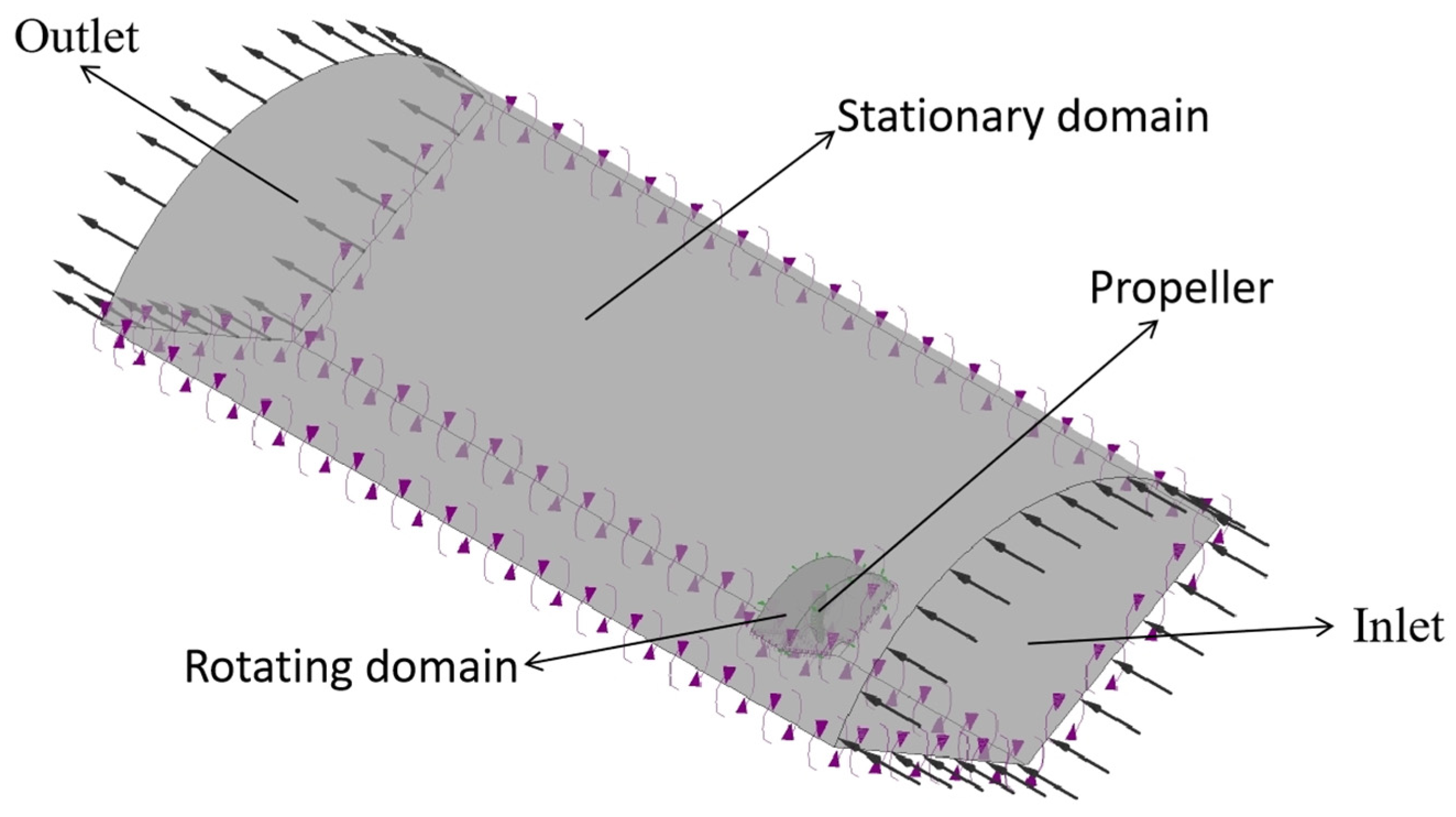
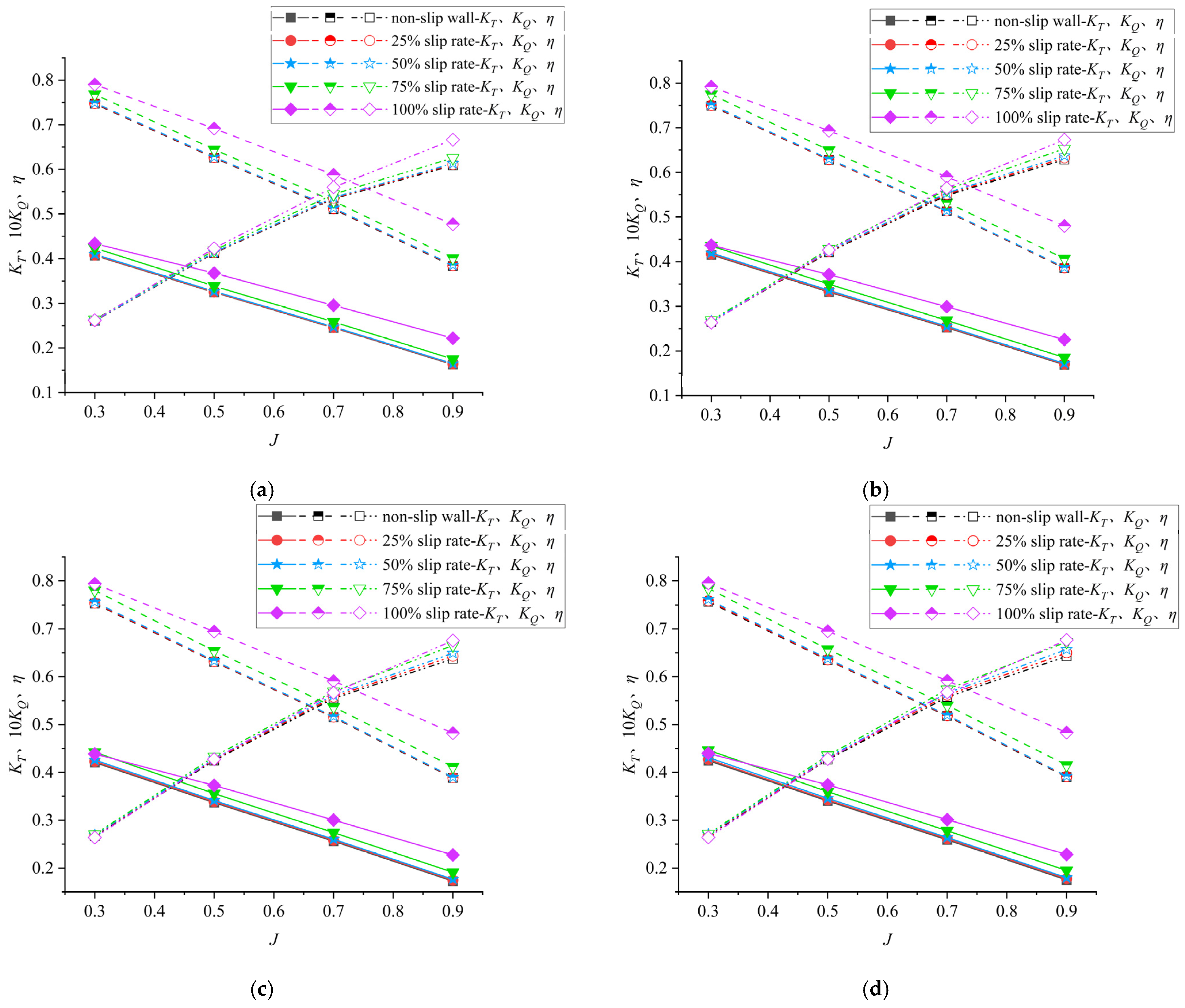
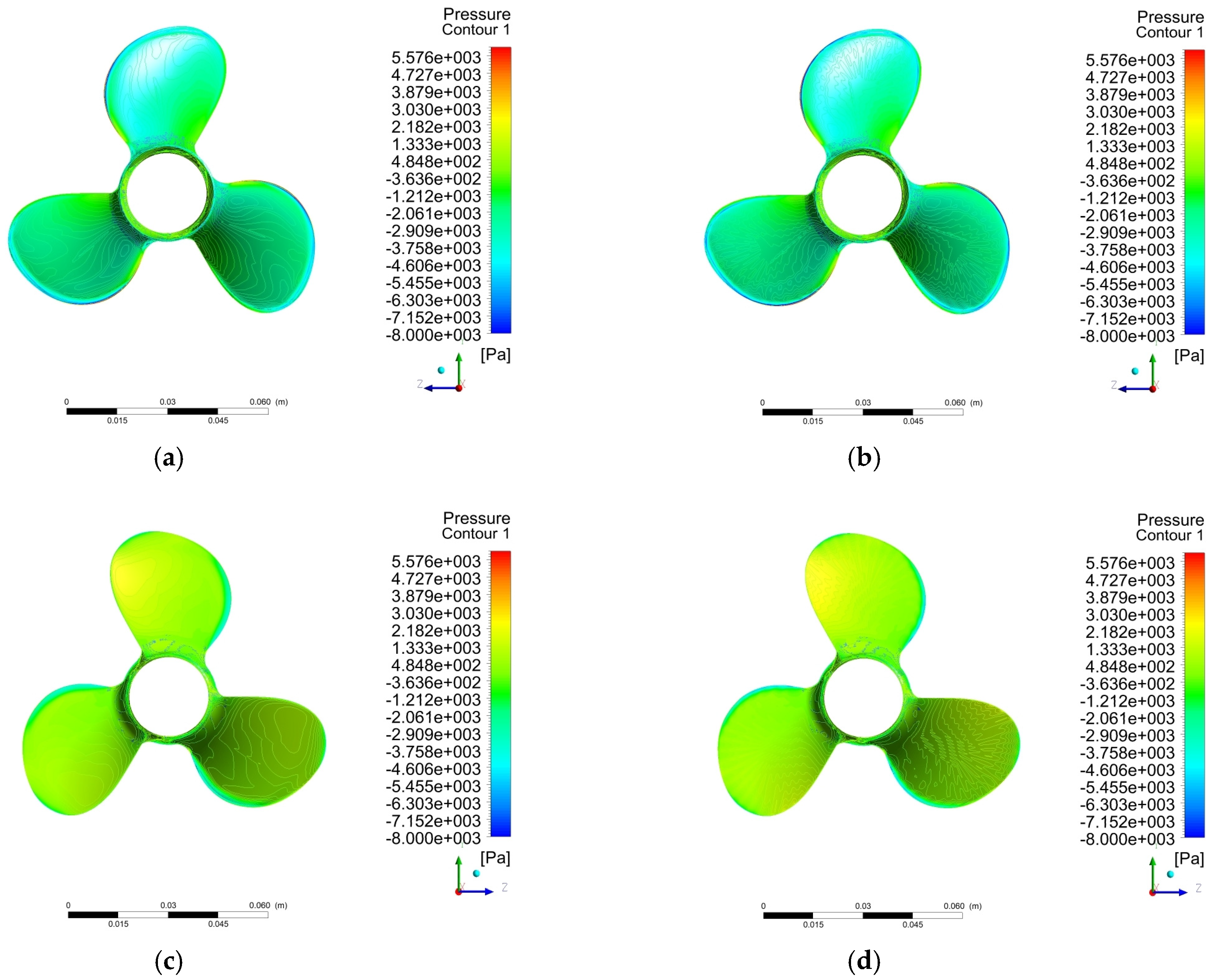
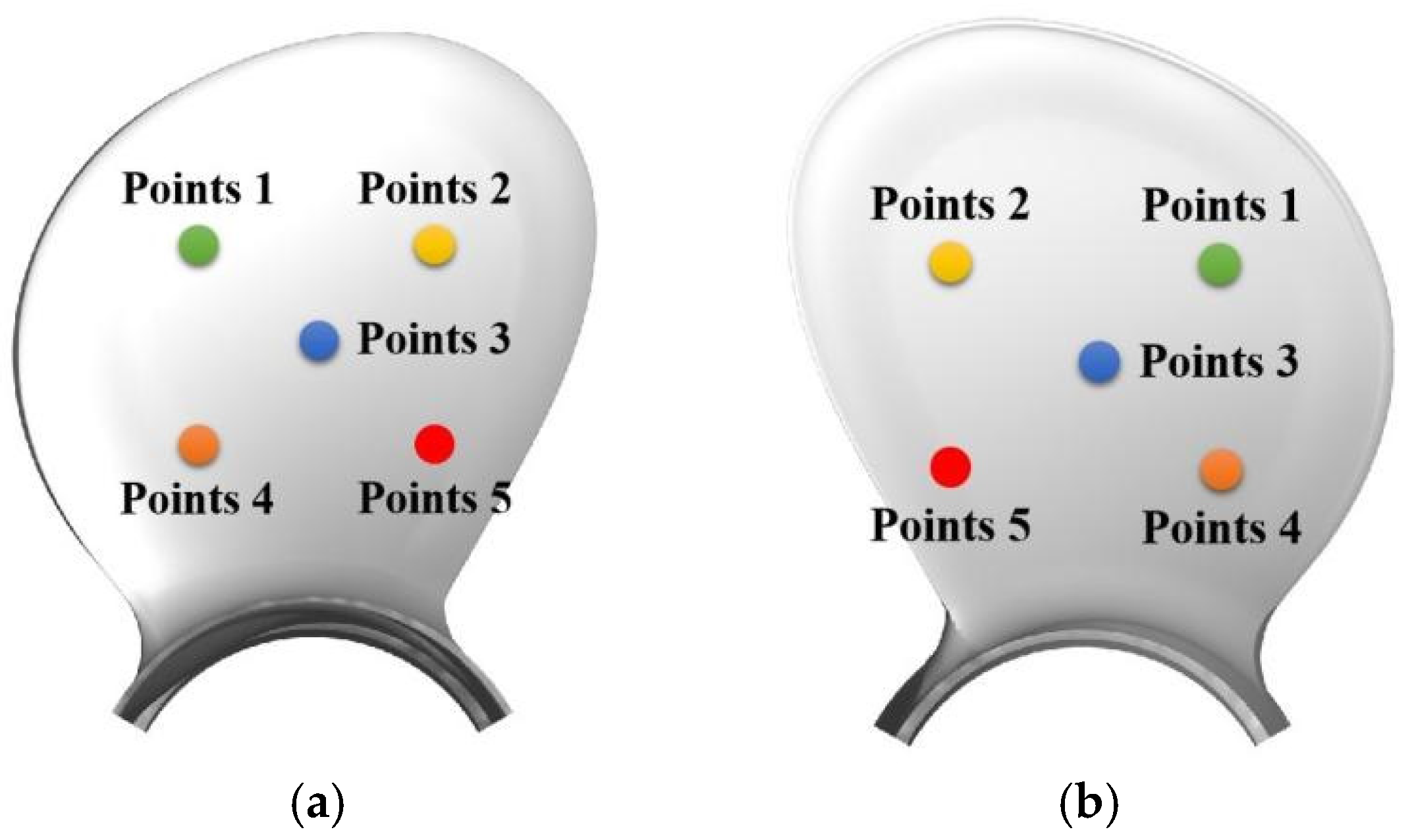
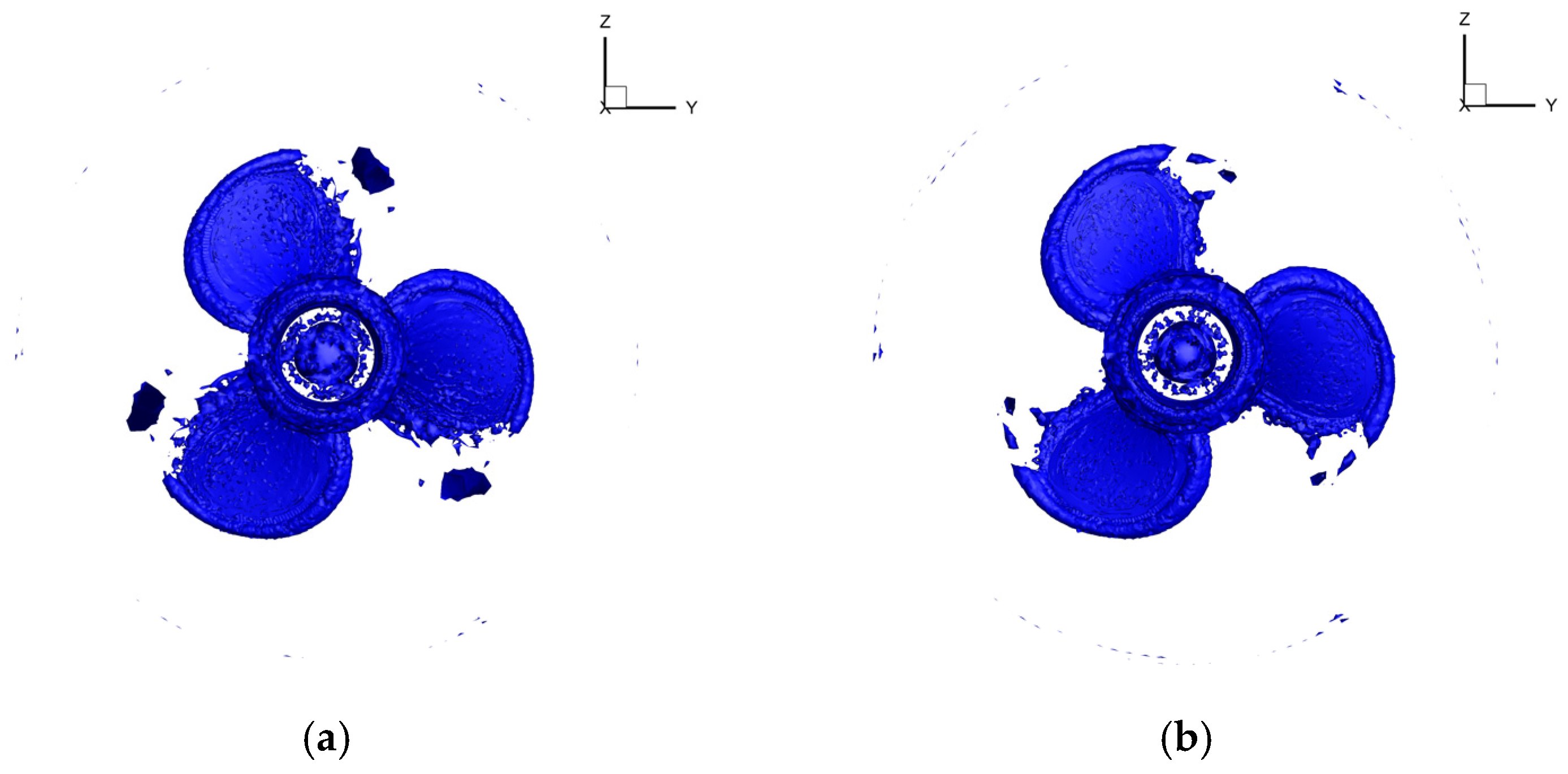
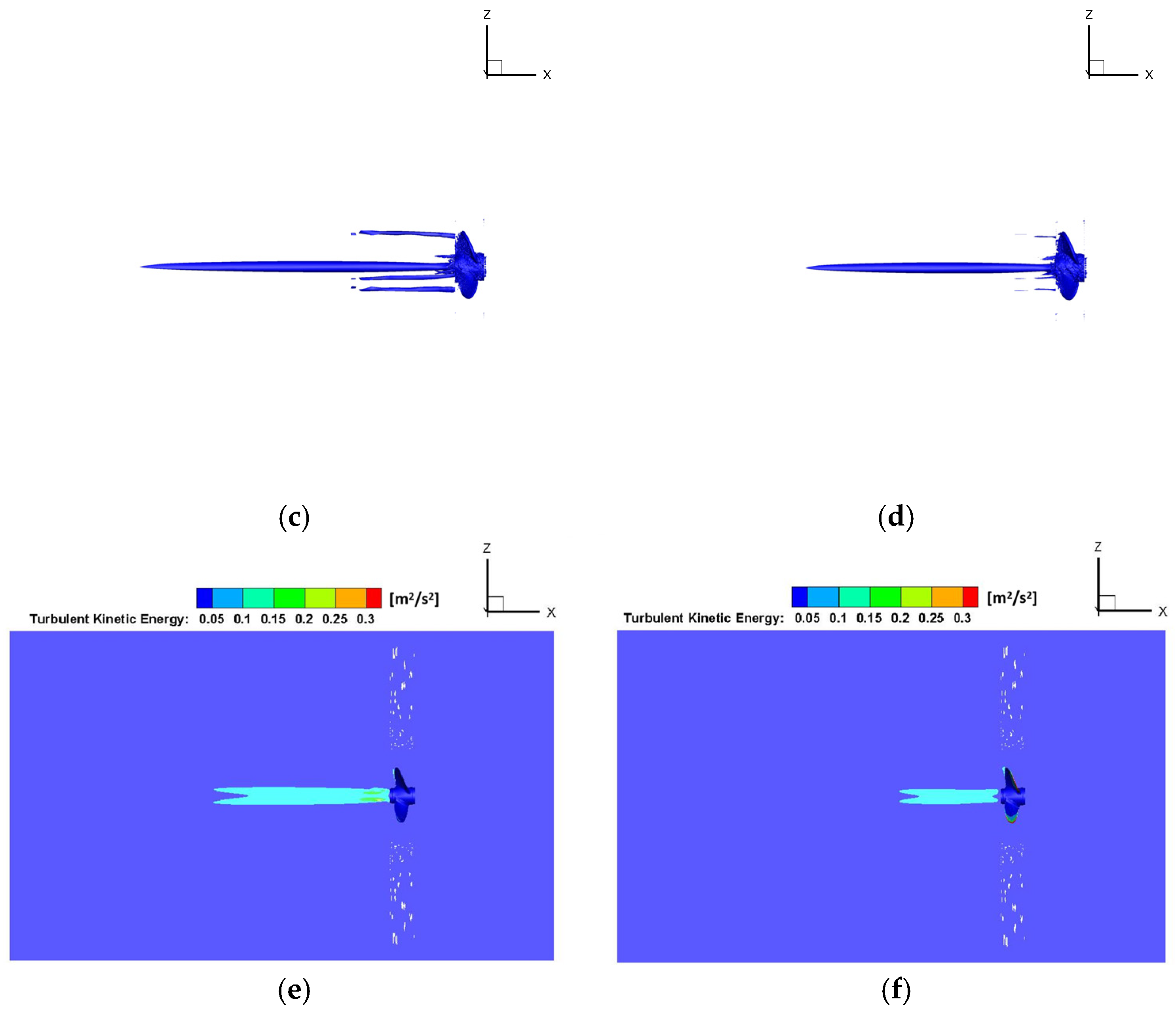
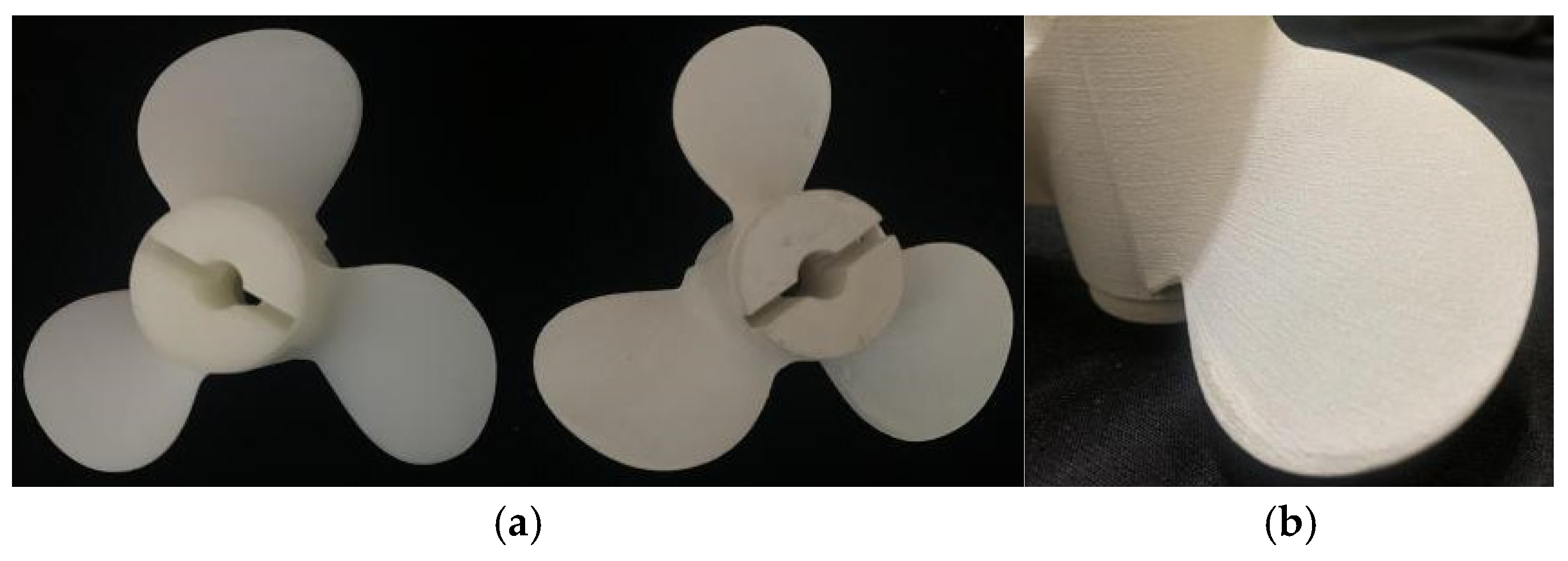
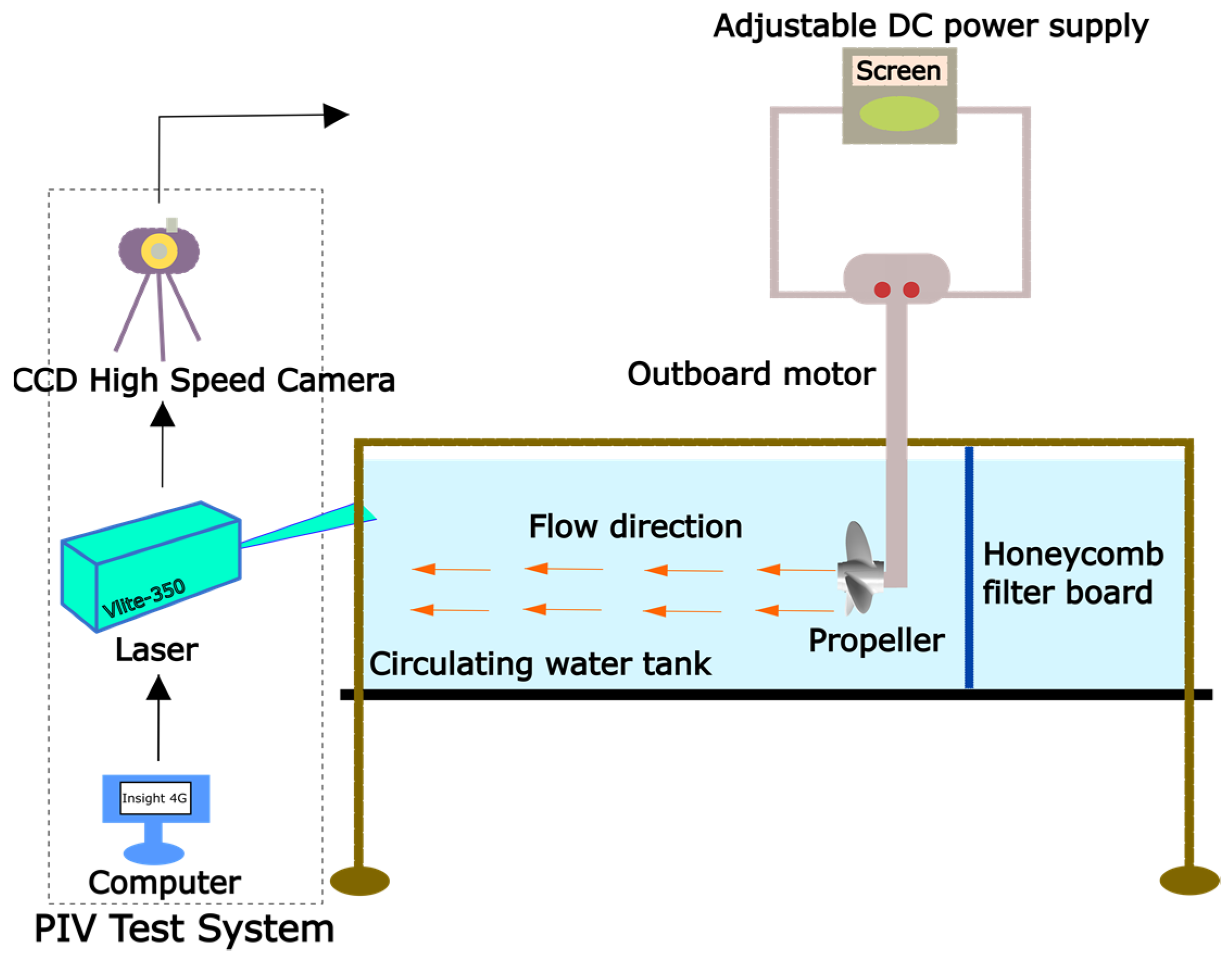
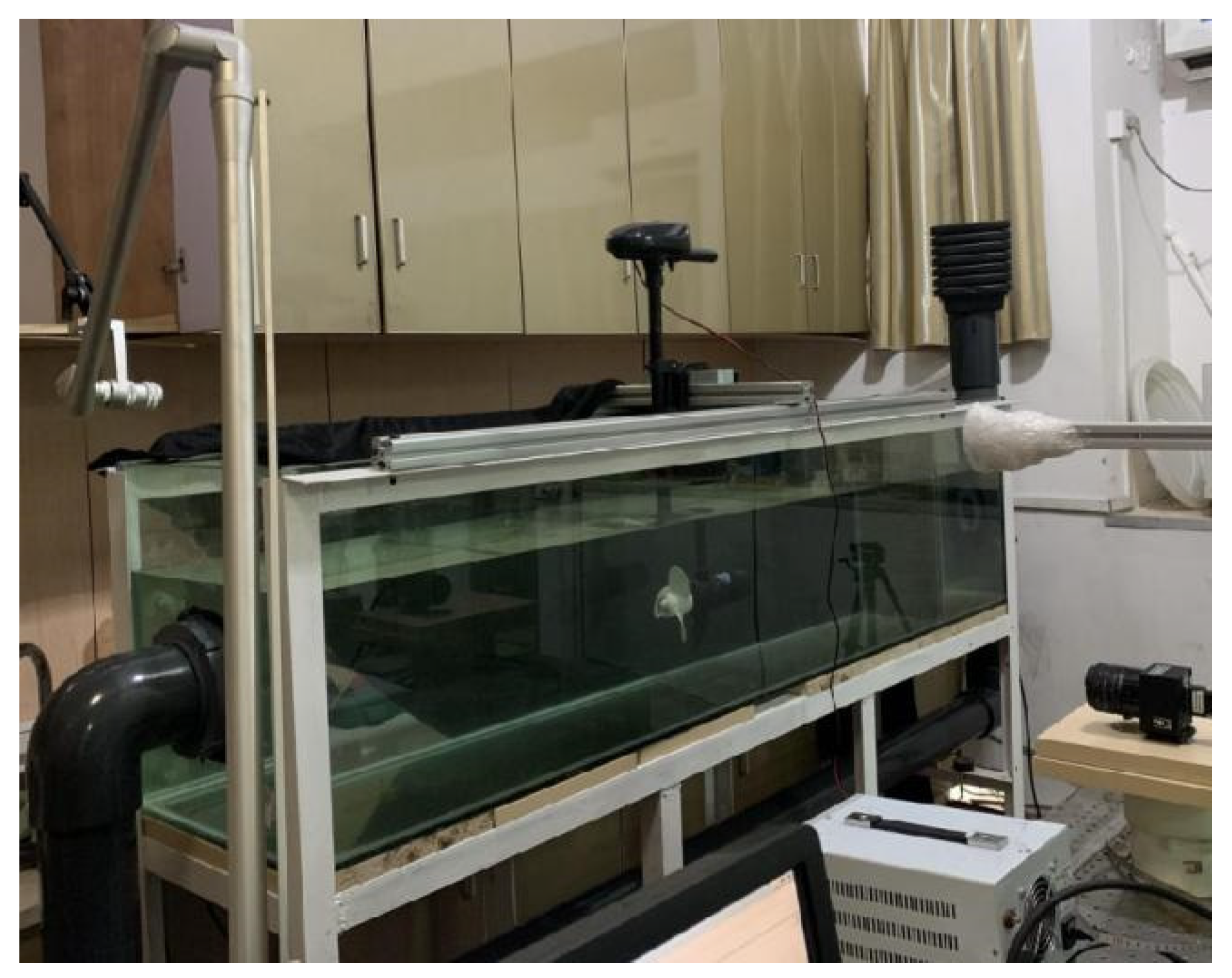

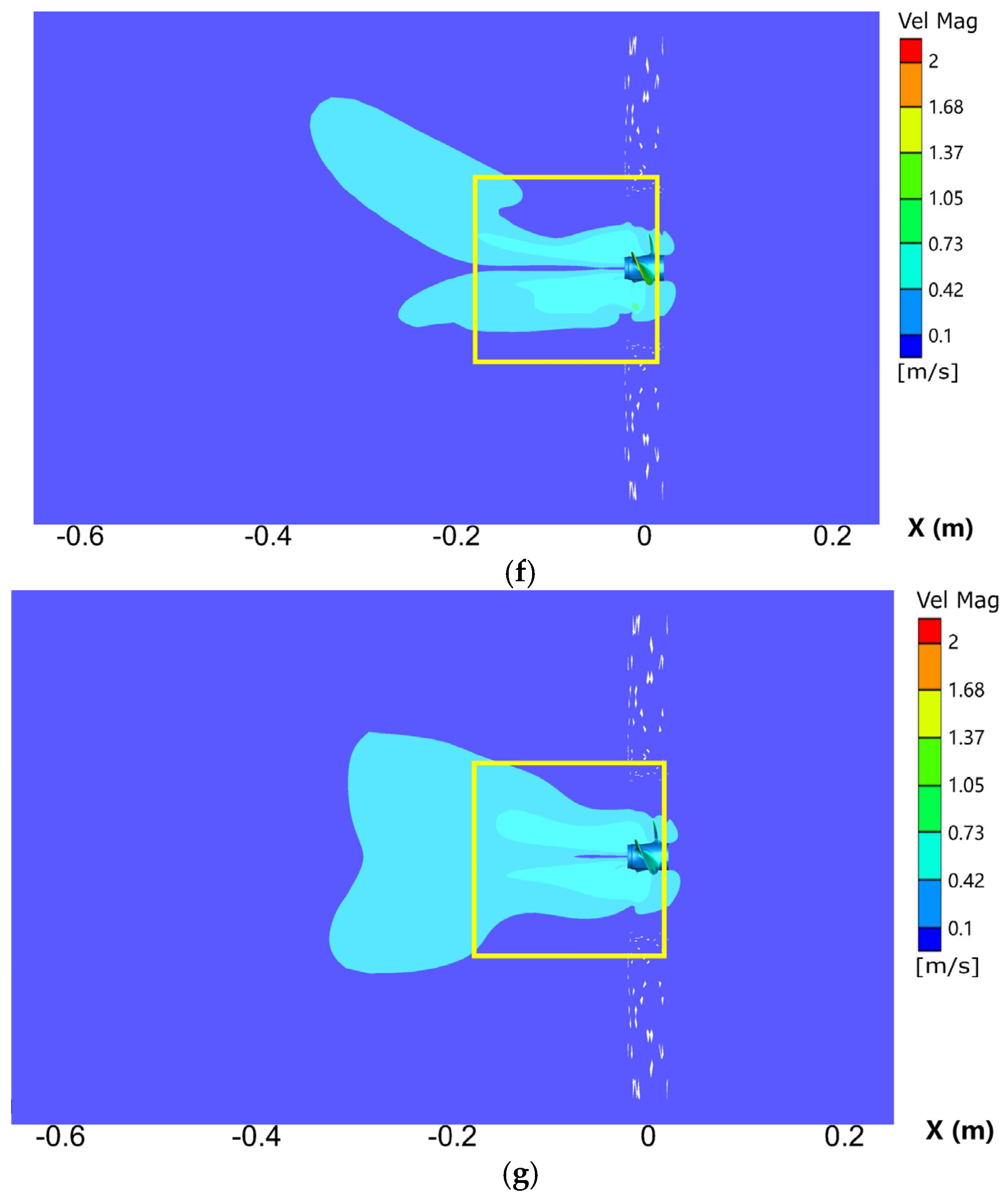
| Number of Blades | Diameter, m | Solidity | Hub Ratio |
|---|---|---|---|
| 3 | 0.1 | 0.2141 | 0.113 |
| Propeller Surface Slip Rate | Surface Slip Condition Setting |
|---|---|
| 0% or non-slip | S1, S2, S3, S4 non-slip |
| 25% | S1 free slip; S2, S3, S4 non-slip |
| 50% | S1, S3 non-slip; S2, S4 free slip |
| 75% | S1 non-slip; S2, S3, S4 free slip |
| 100% | S1, S2, S3, S4 free slip |
| Working Condition | Speed Coefficient | Rotating Speed, r/min |
|---|---|---|
| Case 1 | 0.3 | 300 |
| Case 2 | 0.3 | 600 |
| Case 3 | 0.3 | 900 |
| Case 4 | 0.3 | 1200 |
| Case 5 | 0.5 | 300 |
| Case 6 | 0.5 | 600 |
| Case 7 | 0.5 | 900 |
| Case 8 | 0.5 | 1200 |
| Case 9 | 0.7 | 300 |
| Case 10 | 0.7 | 600 |
| Case 11 | 0.7 | 900 |
| Case 12 | 0.7 | 1200 |
| Case 13 | 0.9 | 300 |
| Case 14 | 0.9 | 600 |
| Case 15 | 0.9 | 900 |
| Case 16 | 0.9 | 1200 |
| Propeller Rotating Speed n, (r/min) | Advance Coefficient J | Efficiency, % | ||||
|---|---|---|---|---|---|---|
| Surface Slip Rate | ||||||
| Non-Slip | 25% | 50% | 75% | 100% | ||
| 300 | 0.3 | 26.04 | 26.08 | 26.13 | 26.35 | 26.22 |
| 300 | 0.5 | 41.27 | 41.35 | 41.44 | 41.86 | 42.32 |
| 300 | 0.7 | 53.44 | 53.56 | 53.71 | 54.44 | 56.01 |
| 300 | 0.9 | 60.89 | 61.08 | 61.33 | 62.56 | 66.64 |
| 600 | 0.3 | 26.50 | 26.58 | 26.67 | 26.85 | 26.35 |
| 600 | 0.5 | 42.11 | 42.26 | 42.42 | 42.86 | 42.63 |
| 600 | 0.7 | 54.86 | 55.11 | 55.38 | 56.16 | 56.49 |
| 600 | 0.9 | 62.86 | 63.27 | 63.73 | 65.30 | 67.31 |
| 900 | 0.3 | 26.69 | 26.80 | 26.90 | 27.06 | 26.39 |
| 900 | 0.5 | 42.47 | 42.68 | 42.89 | 43.30 | 42.75 |
| 900 | 0.7 | 55.44 | 55.77 | 56.13 | 56.92 | 56.66 |
| 900 | 0.9 | 63.74 | 64.31 | 64.92 | 66.56 | 67.56 |
| 1200 | 0.3 | 26.79 | 26.91 | 27.03 | 27.18 | 26.41 |
| 1200 | 0.5 | 42.67 | 42.91 | 43.15 | 43.55 | 42.82 |
| 1200 | 0.7 | 55.74 | 56.15 | 56.58 | 57.34 | 56.75 |
| 1200 | 0.9 | 64.27 | 64.97 | 65.71 | 67.29 | 67.70 |
| Propeller Rotating Speed n, (r/min) | Advance Coefficient J | Efficiency Improvement, % | |||
|---|---|---|---|---|---|
| Surface Slip Rate | |||||
| 25% | 50% | 75% | 100% | ||
| 300 | 0.3 | 0.15 | 0.35 | 1.19 | 0.69 |
| 300 | 0.5 | 0.19 | 0.41 | 1.43 | 2.54 |
| 300 | 0.7 | 0.22 | 0.51 | 1.87 | 4.81 |
| 300 | 0.9 | 0.31 | 0.72 | 2.74 | 9.44 |
| 600 | 0.3 | 0.30 | 0.64 | 1.32 | −0.57 |
| 600 | 0.5 | 0.36 | 0.74 | 1.78 | 1.23 |
| 600 | 0.7 | 0.46 | 0.95 | 2.37 | 2.97 |
| 600 | 0.9 | 0.65 | 1.38 | 3.88 | 7.08 |
| 900 | 0.3 | 0.41 | 0.79 | 1.39 | −1.12 |
| 900 | 0.5 | 0.49 | 0.99 | 1.95 | 0.66 |
| 900 | 0.7 | 0.60 | 1.24 | 2.67 | 2.20 |
| 900 | 0.9 | 0.89 | 1.85 | 4.42 | 5.99 |
| 1200 | 0.3 | 0.45 | 0.90 | 1.46 | −1.42 |
| 1200 | 0.5 | 0.56 | 1.12 | 2.06 | 0.35 |
| 1200 | 0.7 | 0.74 | 1.51 | 2.87 | 1.81 |
| 1200 | 0.9 | 1.09 | 2.24 | 4.70 | 5.34 |
| Suction, Pa | Pressure, Pa | Difference, Pa | |
|---|---|---|---|
| Point 1 | −2020.73 | 402.01 | 2422.74 |
| Point 2 | −2050.32 | 401.95 | 2452.27 |
| Point 3 | −2008.10 | 427.34 | 2435.44 |
| Point 4 | −2344.98 | 56.36 | 2401.34 |
| Point 5 | −1537.71 | 535.24 | 2072.95 |
| Suction, Pa | Pressure, Pa | Difference, Pa | |
|---|---|---|---|
| Point 1 | −1989.61 | 381.26 | 2370.87 |
| Point 2 | −2189.98 | 381.36 | 2571.34 |
| Point 3 | −2066.22 | 466.38 | 2532.60 |
| Point 4 | −2403.11 | 59.62 | 2462.73 |
| Point 5 | −1613.03 | 621.44 | 2234.47 |
Publisher’s Note: MDPI stays neutral with regard to jurisdictional claims in published maps and institutional affiliations. |
© 2022 by the authors. Licensee MDPI, Basel, Switzerland. This article is an open access article distributed under the terms and conditions of the Creative Commons Attribution (CC BY) license (https://creativecommons.org/licenses/by/4.0/).
Share and Cite
Pan, H.; Zeng, R.; Tian, X.; Taalab, E.; Lv, M.; Zhu, Z. Performance of a Propeller Coated with Hydrophobic Material. J. Mar. Sci. Eng. 2022, 10, 236. https://doi.org/10.3390/jmse10020236
Pan H, Zeng R, Tian X, Taalab E, Lv M, Zhu Z. Performance of a Propeller Coated with Hydrophobic Material. Journal of Marine Science and Engineering. 2022; 10(2):236. https://doi.org/10.3390/jmse10020236
Chicago/Turabian StylePan, Huachen, Ran Zeng, Xiaoqing Tian, Elias Taalab, Ming Lv, and Zefei Zhu. 2022. "Performance of a Propeller Coated with Hydrophobic Material" Journal of Marine Science and Engineering 10, no. 2: 236. https://doi.org/10.3390/jmse10020236






